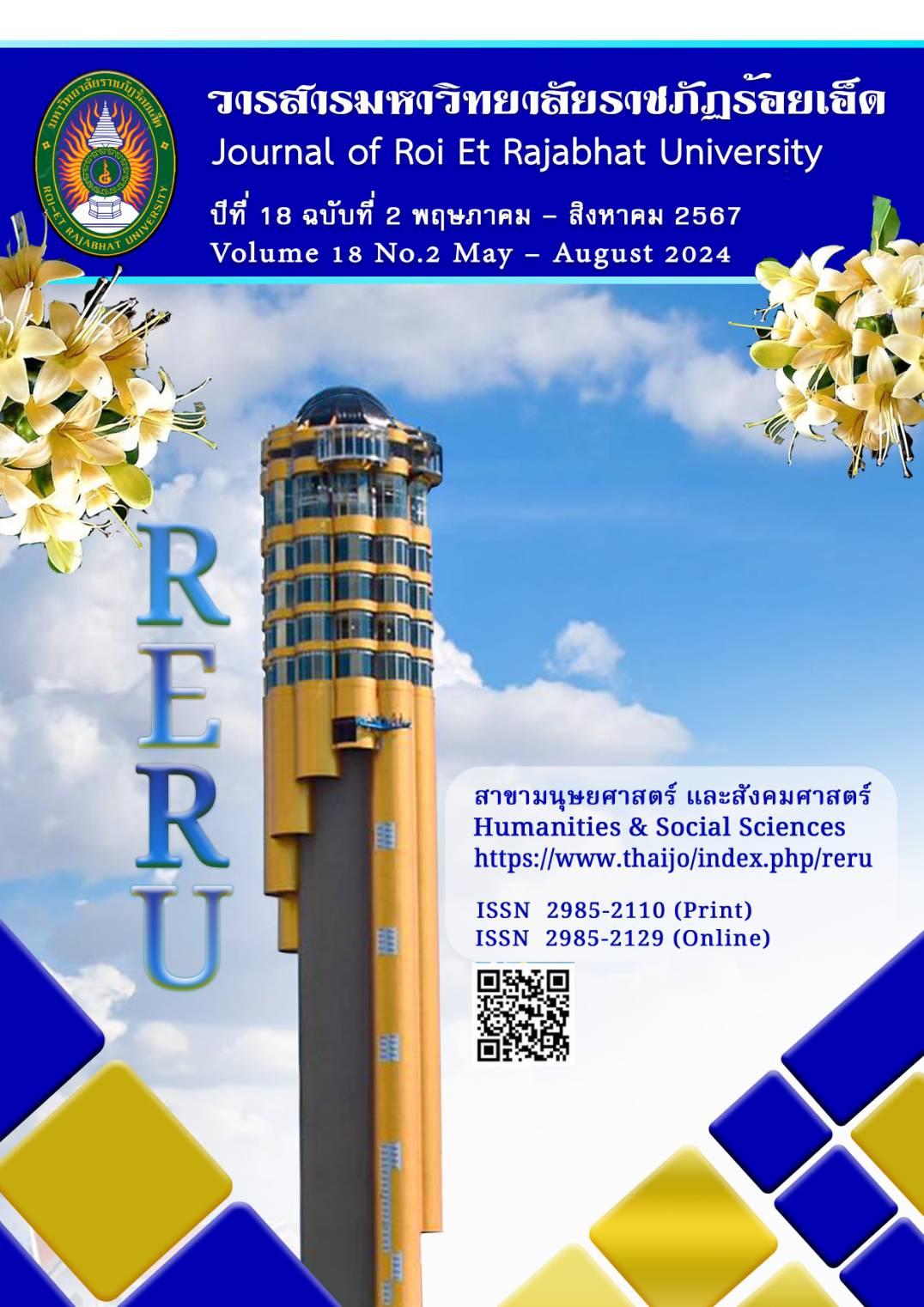Phu Tai Ban Laha Nam Woven Textiles: Language Wisdom and Cultural Dimensions
Keywords:
Phu Tai Laha Nam Woven Textiles, Language Wisdom, Cultural DimensionsAbstract
This research aimed to study the language wisdom and cultural dimensions of the names of the Phu Tai weaving motifs, Ban Laha Nam, Mueang Song Khon, Savannakhet Province, Lao People's Democratic Republic. A qualitative research methodology was employed to collect field data and in-depth interviews with 20 key informants from purposive sampling. Data were analyzed and presented by descriptive analysis. The results of research on language wisdom found that the Phu Tai people of Ban Laha Nam had inherited the wisdom of weaving textiles until now. Most woven textile motifs are created using the Mudmee techniques. All 50 motifs of woven textiles have different names. It showed the wisdom of language in creating words, names, and patterns from objects and nature around them to create motifs design. Language strategies for naming are largely compounded in pattern words as (keyword + adjective), reflecting the wisdom of using language to convey the characteristics of motifs. The assembly can create an excellent motif and sub-motif. As for the cultural dimension, it was found that the names of woven textile motifs can be grouped into five groups: objects, animals, plants, geometrics and natural environment. It shows that in the Phu Tai culture, Ban Laha Nam has a connection with nature and the traditional beliefs about Naga, which are common beliefs in the Mekong Basin countries.
References
จรัญ ชัยประทุม. (2556). ผ้าทอหลวงพระบาง: มิติทางวัฒนธรรมและภูมิปัญญาท้องถิ่น. วารสารศิลปกรรมศาสตร์ มหาวิทยาลัยขอนแก่น, 5(1), 129-156.
ชนิดา ตั้งถาวรสิริกุล. (2541). สื่อสัญลักษณ์ผ้าลาวเวียงจันท์. กรุงเทพฯ: สำนักงานกองทุนสนับสนุนการวิจัย.
ณรงค์ เจนใจ และกรกนก สนิทวงศ์. (2565). เอกลักษณ์ลวดลายผ้าทอบ้านวังผาและบ้านวังศิลา ตำบลสันมะค่า อำเภอป่าแดด จังหวัดเชียงราย. วารสาร มจร การพัฒนาสังคม, 7(3), 110-122.
นิตยา ฉัตรเมืองปัก. (2555). การศึกษาวิเคราะห์ผ้าไหมมัดหมี่อำเภอนาโพธิ์ จังหวัดบุรีรัมย์. วิทยานิพนธ์ การศึกษามหาบัณฑิต สาขาวิชาศิลปศึกษา. กรุงเทพฯ: มหาวิทยาลัยศรีนครินทรวิโรฒ
พิจิตรา พาณิชย์กุล. (2547). การศึกษาชื่อและระบบการทอซิ่นมัดหมี่ดั้งเดิมของคนไทพวนอำเภอบ้านหมี่ จังหวัดลพบุรี ตามแนวอรรถศาสตร์ชาติพันธุ์. วิทยานิพนธ์ อักษรศาสตรมหาบัณฑิต สาขาวิชาภาษาศาสตร์. กรุงเทพฯ: จุฬาลงกรณ์มหาวิทยาลัย.
พิษณุ เข็มพิลา และกฤษฎา ศรีธรรมา. (2550). การศึกษาลวดลายผ้าห่อคัมภีร์ใบลานอีสาน. มหาสารคาม: มหาวิทยาลัยราชภัฏมหาสารคาม.
ยศกร สิทธิศักดิ์ไพบูลย์. (2553). การศึกษาชื่อลายแพรวาในภาษาผู้ไทยตามแนวอรรถศาสตร์ชาติพันธุ์. วารสารวิจัย มข. (ฉบับบัณฑิตศึกษา) มหาวิทยาลัยขอนแก่น, 10(1), 126-133.
วิจินตน์ ภาณุพงศ์. (2555). บรรทัดฐานภาษาไทย เล่ม 3 : ชนิดของคำ วลี ประโยค และสัมพันธสาร (พิมพ์ครั้งที่ 2). กรุงเทพฯ: สถาบันภาษาไทย สำนักวิชาการและมาตรฐานการศึกษา สำนักงานคณะกรรมการการศึกษาขั้นพื้นฐาน กระทรวงศึกษาธิการ.
วิรินชุอร พิมสาร. (2559). การออกแบบลายผ้าจากผ้าทอเมืองน่าน. ภาคนิพนธ์ ศิลปกรรมศาสตรบัณฑิต สาขาวิชานิเทศศิลป์. กรุงเทพฯ: สถาบันเทคโนโลยีพระจอมเกล้าเจ้าคุณทหารลาดกระบัง.
อมรา ประสิทธิ์รัฐสินธุ์. (2549). กว่าจะเป็นนักภาษาศาสตร์. กรุงเทพฯ: โรงพิมพ์แห่งจุฬาลงกรณ์มหาวิทยาลัย.
อมรา ประสิทธิ์รัฐสินธุ์, กัณฑิมา รักวงษ์วาน, มนสิการ เฮงสุวรรณ และสิริวิมล ศุกรศร. (2555). บุคคลสำคัญและความคิดหลักในอรรถศาสตร์ชาติพันธุ์: การเข้าถึงวัฒนธรรมโดยผ่านภาษา. กรุงเทพฯ: โรงพิมพ์แห่งจุฬาลงกรณ์มหาวิทยาลัย.
Downloads
Published
How to Cite
Issue
Section
License
Copyright (c) 2024 Roi Et Rajabhat University

This work is licensed under a Creative Commons Attribution-NonCommercial-NoDerivatives 4.0 International License.
บทความที่ได้รับการตีพิมพ์เป็นลิขสิทธิ์ของวารสารมหาวิทยาลัยราชภัฎร้อยเอ็ด
ข้อความที่ปรากฏในบทความแต่ละเรื่องในวารสารวิชาการเล่มนี้เป็นความคิดเห็นส่วนตัวของผู้เขียนแต่ละท่านไม่เกี่ยวข้องกับมหาวิทยาลัยราชภัฎร้อยเอ็ด และคณาจารย์ท่านอื่นๆในมหาวิทยาลัยฯ แต่อย่างใด ความรับผิดชอบองค์ประกอบทั้งหมดของบทความแต่ละเรื่องเป็นของผู้เขียนแต่ละท่าน หากมีความผิดพลาดใดๆ ผู้เขียนแต่ละท่านจะรับผิดชอบบทความของตนเองแต่ผู้เดียว





